Al-Mg alloy is a representative non-heat-treatable aluminum alloy. The main strengthening mechanism of the alloy is solid solution hardening by magnesium. The Al-Mg alloy has excellent workability and corrosion resistance, as well as a good balance between strength and ductility. Therefore, the alloy is widely used for various products including automobile parts. Periodic patterns consisting of shiny region and un-shiny region with cracks are observed in the casting direction on the surface of the AC7A (Al-5%Mg) alloy fabricated by the vertical-type high-speed twin-roll casting. Deterioration of surface quality, that is, increase in un-shiny region, is anticipated when magnesium content is increased for higher solid solution hardening effect. In this study, Al-Mg alloy strips with magnesium content varied from 1 % to 12 % was fabricated, and the effect of magnesium composition on the periodic patterns was investigated. Figure 1 shows strip surface appearances in the thickness-constant zone of (a) Al-1%Mg, (b) Al-2%Mg, (c) AC7A (Al-5%Mg), and (d) Al-8%Mg alloy strip fabricated by the vertical-type high-speed twin-roll casting with the roll rotation speed of 60 m/min. On the surface of the strips with the magnesium content of 2 % or more, the periodic patterns were observed. As the magnesium content increased, the contrast of the patterns became clear. Figure 2 shows the cross-sectional images of (a) Al-2%Mg, and (b) Al-8%Mg alloy strip. Granular particles and porosities were observed at the center of the strip thickness as it was sandwiched between the solidified shells. The solidified shell was thicker in the shiny region. That is, the cooling rate near the strip surface changed periodically along the casting direction, which suggests that the cooling rate in the shiny region is larger than that in the un-shiny region. Figure 3 shows cross-sectional images in the near-surface region of (a) Al-2%Mg, and (b) Al-8%Mg alloy strip. Magnesium segregation along grain boundaries was observed in the vicinity of the strip surface in the un-shiny region. It is considered that residual liquid in the inter-dendrites and grain boundaries was squeezed out to the surface by the solidification shrinkage at the region with locally lowered cooling rate. This resulted in the un-shiny region. The amount of magnesium squeezed out to the surface also increases with the increase of magnesium content, and the contrast of the patterns became clear. Figure 4 shows the relationship between the spacing of the periodical patterns and Mg content in the Al-Mg alloy strips fabricated by the vertical-type high-speed twin-roll casting with the roll rotation speed of 30 m/min. The spacing of periodic patterns decreased with increasing magnesium content. Figure 5 shows the relationship between the calculated viscosity of the molten Al-Mg alloy and Mg content. Since the viscosity of the molten alloy decrease as magnesium content increase, the vibration of the molten metal meniscus in the vicinity of the nozzle tip may occur more easily. This is the possible reason why the spacing of periodic patterns becomes small.
Effect of Magnesium Content on Surface Pattern of Al-Mg Alloy Strips
Fabricated by Vertical-Type High-Speed Twin-Roll Casting
[Published in Journal of Japan Foundry Engineering Society, Vol. 91, No. 1 (2019) pp. 21-27]
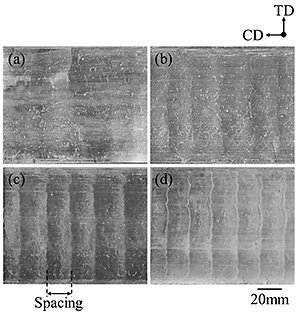 |
| Fig. 1 Strip surface appearance in thickness-constant zone (roll rotation speed of 60 m/min): (a) Al-1%Mg, (b) Al-2%Mg, (c) AC7A (Al-5%Mg), and (d) Al-8%Mg alloy strip. |
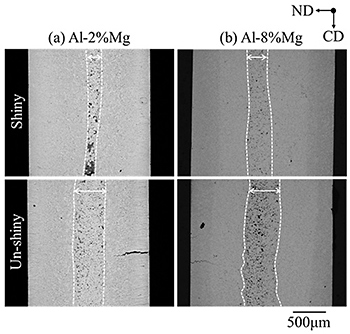 |
| Fig. 2 Cross-sectional images etched by Keller’s reagent: (a) Al-2%Mg, (b) Al-8%Mg alloy strip. |
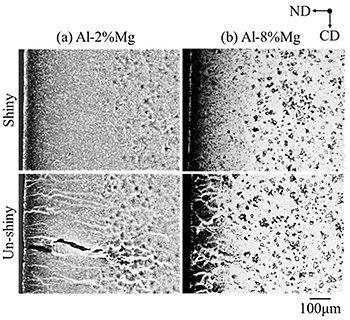 |
|
Fig. 3 Cross-sectional images of near-surface region etched by Weck’s reagent: (a) Al-2%Mg, (b) Al-8%Mg alloy strip. |
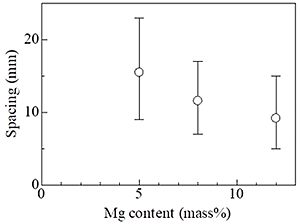 |
| Fig. 4 Relationship between spacing of periodical patterns in thickness-constant zone and Mg content in Al-Mg alloy strips (roll rotation speed of 30 m/min). |
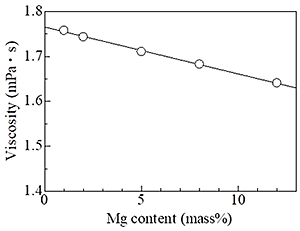 |
| Fig. 5 Relationship between calculated viscosity of molten Al-Mg alloy and Mg content. |